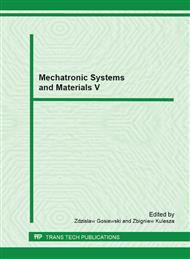[1]
E. Kulesza, J.R. Dąbrowski, J. Sidun, A. Neyman, J. Mizera: Zużycie Frettingowe Materiałów – Aspekty Metodyczne Badań. VI International Symposium on Mechanics of Materials and Structures, Augustów 30. 05 – 02. 06. 2011, s 94-95.
Google Scholar
[2]
P. Schaaff: The role of fretting damage in total hip arthoplasty with modular design hip joint - evaluation of retrieval studies and experimental simulation methods. Journal of Applied Biomaterials and Biomechanics 2004, 2, 121-135.
Google Scholar
[3]
N.J. Hallab: Fretting Corrosion of Orthopedic Implants, Rush University Medical Center, Chicago, IL, USA, Elsevier 2011, 89-96.
DOI: 10.1016/b978-0-08-055294-1.00205-1
Google Scholar
[4]
A.M. Ektessabi, S. Shikine et all.: Friction wear and dissolution of orthopedic implant systems. International Journal of PIXE, Vol. 10, Nos. 1&2 (2000), 37-45.
DOI: 10.1142/s0129083500000067
Google Scholar
[5]
J. Geringer, B. Forest, P. Combrade: Fretting-corrosion of materials used as orthopedic implants, Wear 259 (2005) 943-951.
DOI: 10.1016/j.wear.2004.11.027
Google Scholar
[6]
M. Varenberg, I. Etsion, G. Halperin: Slip index: a new unified approach to fretting, Tribology Letters, Vol. 17, No. 3, October (2004).
DOI: 10.1023/b:tril.0000044506.98760.f9
Google Scholar
[7]
E. Sauger, L. Ponsonnet, J.M. Martin, L. Vincent: Study of the tribologically transformed structure created during fretting tests, Tribology International 33 (2000), 743-750.
DOI: 10.1016/s0301-679x(00)00088-8
Google Scholar
[8]
Z.R. Zhou, K. Nakazawa, M.H. Zhu, N. Maruyama, Ph. Kapsa, L. Vincent: Progress in fretting maps, Tribology International 39, 2006, 1068-1073.
DOI: 10.1016/j.triboint.2006.02.001
Google Scholar
[9]
J.J. O`Connor: The role of elastic stress analysis in the interpretation of fretting fatigue failures. In Waterhouse R.B. ed. Fretting Fatigue, London: Applied Science Publishers, (1981).
Google Scholar
[10]
M. J. Neale: The tribology handbook, Elsevier, Oxford (1995).
Google Scholar
[11]
A. Neyman: Studia nad frettingiem. Wpływ struktury węzła styku na zużycie, Zeszyt Naukowy Politechniki Gdańskiej, Mechanika nr 501, Gdańsk (1993).
Google Scholar
[12]
X. Huang, R.W. Neu: High-load fretting of Ti-6Al-4V interfaces in point contact, Wear 265, 2008, 971-978.
DOI: 10.1016/j.wear.2008.02.018
Google Scholar
[13]
I.M. Feng, H.H. Uhlig: Fretting corrosion of mild steel in air and in nitrogen, Journal of Applied Mechanics, 1954, 21, 395-400.
DOI: 10.1115/1.4010939
Google Scholar
[14]
L. Toth: The investigation of the steady stage of steel fretting, Wear 1972, 20, 277-286.
DOI: 10.1016/0043-1648(72)90409-7
Google Scholar
[15]
N. Ohmae, T. Tsukizoe: The effect of slip amplitude on fretting, Wear 1974, 27, 281-294.
DOI: 10.1016/0043-1648(74)90114-8
Google Scholar
[16]
P.L. Hurricks: The mechanism of fretting-a review, Wear 1970, 15, 389-409.
DOI: 10.1016/0043-1648(70)90235-8
Google Scholar
[17]
A.M. Ektessabi, S. Shikine, M. Hamdi, N. Kitamura: Friction wear and dissolution of orthopedic implant systems, International Journal of PIXE, Vol. 10, Nos. 1&2, 2000, 37-45.
DOI: 10.1142/s0129083500000067
Google Scholar
[18]
J. Geringer, B. Forest, P. Combrade: Wear analysis of materials used as orthopedic implants, Wear 2006, 261, 971-979.
DOI: 10.1016/j.wear.2006.03.022
Google Scholar
[19]
L. Duisabeau, P. Combrade, B. Forest: Environmental effect on fretting of metallic materials for orthopedic implants, Wear 2004, 256, 805-816.
DOI: 10.1016/s0043-1648(03)00522-2
Google Scholar


